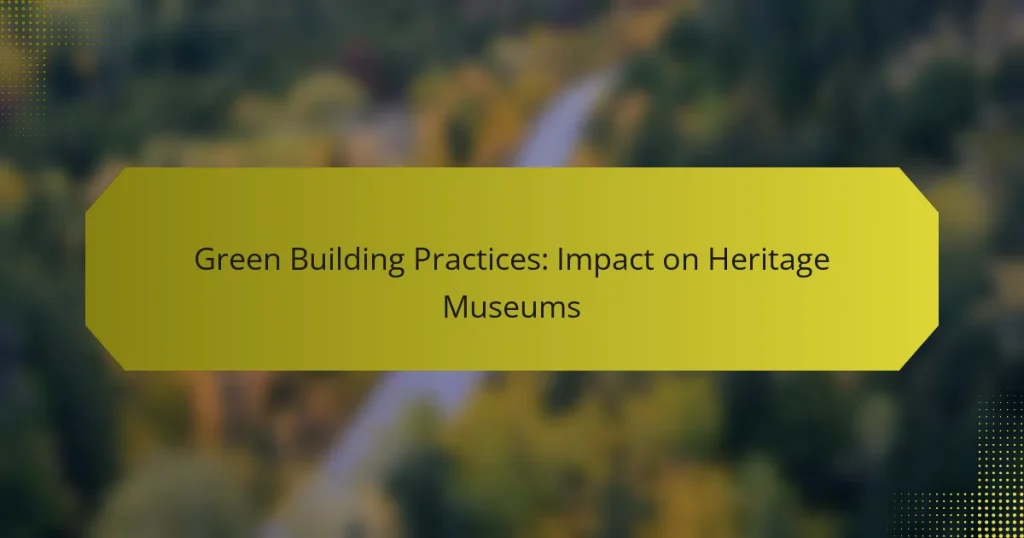Green building practices play a crucial role in enhancing heritage museums by improving energy efficiency and preserving historical integrity. By integrating sustainable materials and energy-efficient systems, these practices not only lower operational costs but also contribute to a more sustainable environment, aligning with the mission of cultural institutions to protect and promote heritage.

How do green building practices benefit heritage museums?
Green building practices significantly enhance heritage museums by improving energy efficiency, enriching visitor experiences, and preserving historical integrity. These practices not only reduce operational costs but also foster a sustainable environment that aligns with the mission of many cultural institutions.
Energy efficiency improvements
Implementing energy-efficient systems in heritage museums can lead to substantial reductions in energy consumption. Upgrading to LED lighting, improving insulation, and utilizing renewable energy sources like solar panels can cut energy costs by 20-50%. These upgrades not only lower utility bills but also minimize the carbon footprint of the museum.
When considering energy efficiency, it’s essential to conduct an energy audit to identify areas for improvement. Museums should prioritize solutions that maintain the aesthetic and functional aspects of the building while enhancing performance. For example, installing energy-efficient HVAC systems can improve climate control without compromising the integrity of artifacts.
Enhanced visitor experience
Green building practices can significantly enhance the visitor experience in heritage museums. Improved air quality, natural lighting, and comfortable temperatures contribute to a more enjoyable and engaging atmosphere. Museums that adopt sustainable practices often report increased visitor satisfaction and longer dwell times.
Incorporating interactive exhibits that educate visitors about sustainability can further enrich their experience. For instance, displays that explain the museum’s green initiatives can foster a deeper connection between visitors and the institution, encouraging them to support sustainability efforts.
Preservation of historical integrity
Maintaining the historical integrity of heritage museums is crucial when implementing green building practices. Sustainable renovations should respect the original architecture and materials while integrating modern technologies. This balance ensures that the museum’s character and significance remain intact.
Utilizing materials that are both sustainable and historically appropriate can help preserve the museum’s authenticity. For example, using reclaimed wood for renovations not only supports sustainability but also aligns with the historical narrative of the building. It’s vital to consult preservation experts during the planning stages to ensure that all changes honor the museum’s heritage.

What are effective green building practices for heritage museums?
Effective green building practices for heritage museums focus on sustainability while preserving historical integrity. These practices include using sustainable materials, implementing energy-efficient systems, and employing water conservation techniques to minimize environmental impact.
Use of sustainable materials
Utilizing sustainable materials is crucial for heritage museums to maintain their historical character while promoting eco-friendliness. Materials such as reclaimed wood, recycled metals, and low-VOC (volatile organic compounds) paints can significantly reduce the carbon footprint.
When selecting materials, consider their life cycle impact, including sourcing, manufacturing, and disposal. For example, using locally sourced materials can lower transportation emissions and support the local economy.
Implementing energy-efficient systems
Energy-efficient systems are essential for reducing operational costs and environmental impact in heritage museums. Installing LED lighting, smart HVAC systems, and energy-efficient windows can lead to substantial energy savings.
Consider integrating renewable energy sources, such as solar panels, to further enhance sustainability. It’s important to assess the building’s orientation and local climate to maximize energy efficiency and minimize reliance on non-renewable resources.
Water conservation techniques
Water conservation techniques help heritage museums reduce water usage and promote sustainability. Implementing low-flow fixtures, rainwater harvesting systems, and drought-resistant landscaping can significantly decrease water consumption.
Regular maintenance of plumbing systems is vital to prevent leaks and ensure efficient water use. Museums should also educate visitors about the importance of water conservation, fostering a culture of sustainability within the community.

How can heritage museums in the UK adopt green building practices?
Heritage museums in the UK can adopt green building practices by integrating sustainable materials, energy-efficient systems, and eco-friendly technologies into their existing structures. This approach not only preserves the integrity of historical sites but also reduces their environmental impact.
Case studies of successful implementations
Several heritage museums in the UK have successfully implemented green building practices. For instance, the Museum of London Docklands underwent a significant renovation that included energy-efficient lighting and improved insulation, resulting in reduced energy costs and a smaller carbon footprint.
Another example is the Victoria and Albert Museum, which has incorporated rainwater harvesting and green roofs in its expansion projects. These sustainable features enhance biodiversity while providing practical benefits like reduced water usage.
Government incentives and funding
The UK government offers various incentives to encourage heritage museums to adopt green building practices. Programs such as the Heritage Lottery Fund provide financial support for projects that enhance sustainability while preserving historical significance.
Additionally, museums can benefit from tax reliefs and grants aimed at energy efficiency improvements. Engaging with local councils can also uncover additional funding opportunities tailored to specific community needs and conservation goals.

What are the challenges of integrating green practices in heritage museums?
Integrating green practices in heritage museums presents several challenges, including the need to balance modern sustainability efforts with the preservation of historical integrity. Museums often face constraints related to structural modifications, funding, and compliance with preservation regulations.
Balancing modern needs with historical preservation
Heritage museums must carefully navigate the tension between implementing modern green technologies and maintaining the authenticity of their historical structures. This often requires innovative solutions that do not compromise the building’s original materials or design. For instance, installing energy-efficient lighting might necessitate using fixtures that blend seamlessly with the museum’s aesthetic.
Collaboration with preservation experts is essential to ensure that any green upgrades respect the building’s historical significance. Regular assessments can help identify areas where modern needs can be met without detracting from the museum’s heritage.
Cost implications and budgeting
Implementing green practices in heritage museums can involve significant upfront costs, which may deter some institutions from pursuing these initiatives. Budgeting for sustainable upgrades requires a comprehensive understanding of both immediate expenses and long-term savings, such as reduced energy bills. Museums should consider applying for grants or partnerships that focus on sustainability to alleviate financial burdens.
Additionally, museums should prioritize cost-effective solutions, such as improving insulation or upgrading HVAC systems, which can yield substantial energy savings over time. Creating a phased implementation plan can help manage costs while gradually enhancing sustainability efforts.

What criteria should be considered for green renovations in heritage museums?
When planning green renovations in heritage museums, key criteria include regulatory compliance, community engagement, and sustainability practices. These factors ensure that renovations respect the historical significance while enhancing energy efficiency and visitor experience.
Regulatory compliance
Regulatory compliance involves adhering to local, national, and international standards that govern heritage conservation and environmental sustainability. Museums must navigate regulations such as the National Historic Preservation Act in the U.S. or similar laws in other countries, which dictate how renovations can be conducted without compromising the integrity of the site.
It is crucial to consult with local heritage boards and environmental agencies early in the renovation process. This helps to identify necessary permits and avoid costly delays. For instance, using eco-friendly materials may require specific certifications that align with both heritage and environmental regulations.
Community engagement and feedback
Engaging the community is vital for successful green renovations in heritage museums. Gathering feedback from local stakeholders, including residents and cultural groups, helps ensure that the renovations reflect community values and needs. This can be achieved through public meetings, surveys, or workshops.
Incorporating community input not only fosters goodwill but can also enhance the museum’s relevance and visitor appeal. For example, a museum might host events to discuss proposed changes, allowing locals to voice their opinions on sustainability initiatives or exhibit updates. This collaborative approach can lead to more successful and accepted renovation outcomes.

What are the emerging trends in green building for heritage museums?
Emerging trends in green building for heritage museums focus on sustainability while preserving historical integrity. These practices aim to reduce environmental impact and enhance visitor experience through innovative technologies and design strategies.
Smart technology integration
Smart technology integration in heritage museums involves using advanced systems to optimize energy efficiency and enhance visitor engagement. This can include smart lighting, climate control, and security systems that adapt to real-time conditions, reducing energy consumption and improving comfort.
For example, museums can implement automated lighting that adjusts based on natural light levels or occupancy sensors that reduce energy use in unoccupied areas. These technologies not only lower operational costs but also help maintain the integrity of sensitive artifacts by controlling environmental factors.
Focus on adaptive reuse
Adaptive reuse is a key trend where existing structures are repurposed for new functions while preserving their historical significance. This approach minimizes waste and the need for new materials, aligning with sustainability goals while honoring the building’s heritage.
Heritage museums can benefit from adaptive reuse by transforming old factories or warehouses into exhibition spaces. This not only saves resources but also creates unique environments that tell a story, appealing to visitors. Careful planning is essential to ensure that renovations respect the original architecture and comply with local preservation regulations.


